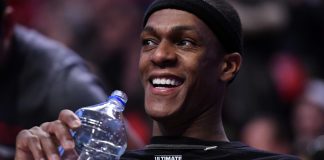The Minnesota Timberwolves have had a tremendous offseason thus far, but the expectations of them may be too much.
On paper, the Timberwolves have an outstanding team. Karl-Anthony Towns, who’s arguably the NBA’s best center after a historic sophomore season, is the anchor and centerpiece. On the perimeter, Tom Thibodeau sacrificed Zach LaVine and Kris Dunn for Jimmy Butler, who’s likely to play shooting guard to Andrew Wiggins’ small forward. Next, the Wolves added Jeff Teague for a cool $57 million over three years after parting ways with Ricky Rubio. Rounding out the lineup are Taj Gibson and Gorgui Dieng, who are both more than serviceable as power forwards, and Jamal Crawford as the likely sixth man.
Whether you cut it with scissors, a steak knife, a fillet knife or whatever, Minnesota has an excellent rotation. On any given night three guys can hang at least 20 points a piece on the opposition. Thibs has also done a commendable job pairing older players with the young ones, and age was a “problem” that haunted the Timberwolves as much as their defense. Still, there are some questions. They’ve improved, but so has the rest of the Western Conference.
Teams are building to beat the Golden State Warriors, who re-signed Kevin Durant and Stephen Curry while adding Nick Young and Omri Caspi. Golden State is the target. And the rest of the teams are aware of this. Houston filled holes adding Chris Paul, Luc Mbah a Moute, Tarik Black and P.J. Tucker; Oklahoma City traded for Paul George before signing Patrick Patterson and Raymond Felton; San Antonio hasn’t done much, but they’re still going to be near the top of the conference. There’s also Denver, who added Paul Millsap, Portland, Utah, New Orleans and Sacramento.
Also Read: Chris Paul Is Patrick Beverley On Steroids
Only a select few of the teams are going to contend, but every night is going to be a dogfight. Making the playoffs is feasible for the Timberwolves, but a deep advancement isn’t. Beating a team like the Warriors, Rockets or Spurs means going above and beyond to address and fortify your flaws. Minnesota hasn’t done it to the same extent as the others.
Last year, they finished 31-51. Throughout the campaign, the Timberwolves had flashes of being a solid team. Some nights they looked incredible. Others saw them get picked apart like a frog during seventh-grade science class.
No matter how high or how low they got, though, there were a few constants — laughable defense and an offense not indicative of the current NBA. The Timberwolves finished the season allowing 106.7 points a night on 47.5 percent shooting, which were 12th- and 3rd-worst in the league, respectively. Regarding volume, the Wolves were a bit below average. Once we adjust for pace, though, things change. Thanks to the introduction of analytics, efficiency has been a huge gauge on how teams perform. Fortunately for us, it’s been more beneficial than detrimental.
For the most part, teams love to get out and run. Utah had the slowest pace this year at 91.6 possessions, and that would’ve been just slightly above-average as recent as 2012 (91.3). Life comes at you fast. But Minnesota has yet to embrace the pace-and-space style. Their pace, 94.6 possessions, was good enough for 25th in the NBA. Pairing a bad defense with fewer possessions is not ideal analytically. As a result, the Timberwolves dropped all the way to 27th in defensive rating as they allowed 112 points per 100. Conversely, their offense was 10th-best at 110.8. It’s a weird paradigm.
Also Read: James Harden Is Worth Every Dollar Houston Gave Him
Furthering the oddity are the principles of Thibodeau, who’s a defensive-first coach. During his tenure with the Chicago Bulls, the team fell out of the top-10 in defensive rating just once, and that was his final seasons. Stopping opponents were their brand. They were blue collar. Minnesota had a hard time adopting those philosophies in Thibs’ first year. Dieng and Towns showed promise on that end, but you can’t classify either as an elite rim protector. They have the potential, however. Towns limited opponents to 59.3 percent shooting inside of six feet, which is 2.1 points less than the average, according to Synergy; Dieng was at 60.9 percent, only 0.3 points less. Taj Gibson helps them tremendously.
He was an anchor for Thibs in Chicago and averaged 1.2 blocks a night in just 25.2 minutes over the course of his seven-and-a-half seasons. The limiting factor on his production was foul trouble. Over that same stretch, Gibson was whistled for 2.6 fouls a night. Now 32-years-old, Gibson’s learned and is a much smarter defender even though his blocked shots have suffered. Pushing that to the side, he’s remained a considerable force in the paint, and his defended field goal percentage inside of six feet was 53.5 percent — a staggering 8.1 points below average.
Minnesota isn’t going to become a stalwart defense because of one acquisition, but it’s a start. Not only that, Gibson knows what Thibs wants on that end and is going to be an invaluable teacher. We also know that Butler is going to bolster the perimeter, and the Wolves finally have some depth helping on drives. Butler is one of the NBA’s best wing defenders, and that’s what Minnesota needs in a conference that has Kevin Durant, Paul George and Kawhi Leonard, among others.
Signing Teague is particularly intriguing for the defense. Anyone pondering if he’s a downgrade from Rubio has a tough decision to make, and it comes down to what you value. For those who die by the numbers, Rubio’s the better option… or is Teague? Rubio averaged more steals a night than his then-Eastern Conference counterpart (1.7 to 1.2), but Teague had a slightly better defensive box plus/minus (minus-0.5 to minus-0.9). On a win shares level, Teague contributed more (2.4 to 1.7), but also played 82 games to Rubio’s 75. If you want to use ESPN’s defensive real plus/minus as the deal breaker, you’d probably side with Rubio (plus-0.76 to minus-0.22.)
There’s no right or wrong answer. Both guys are so close regarding metrics that the only separator is how they look on film. Rubio is certainly a more aggressive defender with better anticipation, but I’d trust Teague more if I had to pick someone for the individual front. Despite being a few inches shorter, Teague has a greater wingspan and is a better athlete. Moreover, he’s performed well enough not to get exposed on an average team like Indiana.

While the two guards are a push on defense, Teague is a flagrant upgrade on offense. He’s a better scorer who can create his shot, and he also does a solid job of stretching the defense by nailing about 36 percent (35.7) of his threes. That’s something the Timberwolves need. Rubio barely cracked 40 percent shooting overall, let alone from three. Now that the Wolves have more firepower, the point guard being a reliable safety net makes their offense even deadlier. Teague is going to get his fair share of open looks, and his quickness allows him to get into the lane and create. He averaged 5.1 free throw attempts a night last year, which was a career-high.
On top of scoring, Teague is more than capable of running an offense, and his execution is nearly on par with Rubio’s. Teague isn’t as flashy and won’t complete the jaw-dropping pass as often, but he’ll find the open man and is a savvy decision-maker; his turnover percentage was 16.5 and was the higher-usage player.
Teague’s skills as a passer and all-around scorer are even more necessary now that Butler’s on the wing. Minnesota shot 34.9 percent from three as a team last year, the 10th-worst mark in the NBA. LaVine was a lights-out shooter who helped raise that clip, but he’s not there anymore, and his stroke gave Wiggins and Towns room to operate.
I don’t believe that we’re talking about the Butler-Wiggins duo quite enough. Yes, Butler is a star and Wiggins is a talented scorer, but they’re almost identical when it comes to putting the ball in the basket:
- Butler - 23.9 points a night with a 45.5/36.7/86.5 slash line
- Wiggins - 23.6 points with a 45.2/35.6/76.0 slash line.
Butler is more polished, but Wiggins has developed at an exceptional rate and will continue to grow. Them getting points isn’t a problem for Minnesota. It’s how they do it. Butler has the edge from the free throw line and gets their far more often than Wiggins (8.9 a night to 6.6). Jimmy G. is also a better playmaker and averaged 5.5 assists to Wiggins’ 2.3. He won’t be asked to do that as often with Teague running the show, but it doesn’t hurt having a wing who can create for others.
What worries me more than anything is their reluctance to shoot from the perimeter. Wiggins and Butler shot 289 and 248 threes, respectively, which wasn’t even 20 percent of their attempts. When they weren’t teammates, it wasn’t an issue. I don’t know how well it works going forward, but there are worse problems to have. At first, yes, there will be growing pains. But those were going to happen regardless. Either Butler or Wiggins will turn into a three-point threat, and it could be either one.

Being a “threat” from distance doesn’t mean waking up one day and hitting 40 percent of 12 attempts. It could be as simple as shooting 39 percent on five attempts; being just accurate enough for the defense not to help off of you when someone drives, and Minnesota has a handful of guys who can get to the basket.
I was going to end my piece here, but then realized I left out a blurb on Jamal Crawford. That’s an unforgivable offense.
Crawford isn’t going to have as big an impact as Butler, Teague or Towns, but Thibs is going to figure out a way to incorporate him. Despite being 37, he can still get buckets from time-to-time and isn’t a poor guy to play offense-defense with at the end of a game. Even after 17 seasons, Crawford is still a handful to guard when hot. The Timberwolves have enough weapons to mask him during dry spells, and also to hide him on defense for the sporadic minutes he plays.
The Minnesota Timberwolves are officially League Pass worthy. They were last year, but this team is much better. However, they’re going to struggle, and I think we should all brace ourselves for the growing pains that they’re going to have. Based on the roster, they have everything needed to be a top-eight team, but proclaiming them top-four or even top-five is a stretch. Butler and Wiggins will have to learn how to co-exist. The defense isn’t going to be elite right away — if at all. Only time will show us how successful they are, but hopefully, we hear Thibs shouting come late-April and May.
Start a conversation with me on Twitter

